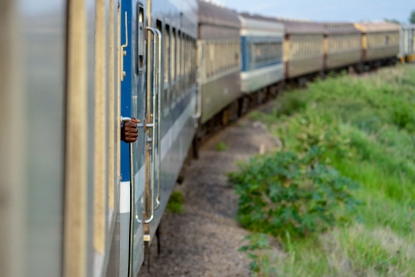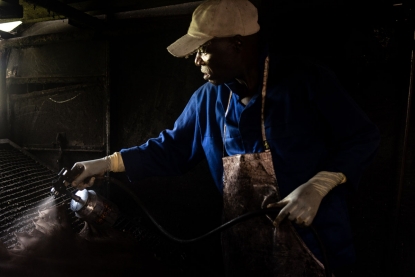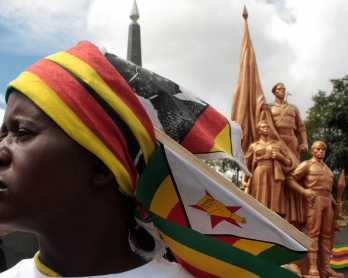Travels through Zimbabwe
Harare -- I well remember sitting in the AFP bureau in Harare at dusk on November 21, 2017 and hearing the first whoop of delight in the street outside when Robert Mugabe was finally ousted, an extraordinary moment in Africa's post-colonial history.
Recently, I was back in Zimbabwe to take a 1,000-km road trip, travelling from the capital Harare across the agricultural heartland to the second city of Bulawayo and then south, down to the land border at Beitbridge into South Africa.
The trip was to report on the country's troubled post-Mugabe "reboot" and to seek stories away from the news headlines and outside the political scene of Harare.
 A makeshift ticket office made out of an old carriage sitting in a field on January 29, 2019 in the sprouting township of Cowdray Park in Bulawayo, Zimbabwe. (AFP / Zinyange Auntony)
A makeshift ticket office made out of an old carriage sitting in a field on January 29, 2019 in the sprouting township of Cowdray Park in Bulawayo, Zimbabwe. (AFP / Zinyange Auntony)Determined to make the best of our unexpected press accreditation, I teamed up with Bulawayo-based photographer Zinyange Auntony and South African AFP video journalist Maryke Vermaak.
We hired a white VW pick-up at Harare airport, collected our media cards, and hit the road heading southwest towards Bulawayo.
 Passengers buy tickets at the main station for a commuter train to Cowdray Park and surrounding townships on January 28, 2019, in Bulawayo, Zimbabwe. (AFP / Zinyange Auntony)
Passengers buy tickets at the main station for a commuter train to Cowdray Park and surrounding townships on January 28, 2019, in Bulawayo, Zimbabwe. (AFP / Zinyange Auntony)Not far outside Harare, the effect of Zimbabwe's land seizures under Mugabe nearly 20 years ago was clearly evident.
Old, large commercial farms once owned by whites were now often abandoned except for thatched homesteads surrounded by subsistence farming with small fields tilled with ox-drawn ploughs.
The road is Zimbabwe's major highway and in good condition, but traffic was scarce due to the chronic petrol shortage and a sudden rise in government-set fuel prices that sparked the latest bout of violent protests.
 Schoolgirls plait their hair next to a railway line as they wait to board a train on January 29, 2019 in Cowdray Park township, in Bulawayo, Zimbabwe. (AFP / Zinyange Auntony)
Schoolgirls plait their hair next to a railway line as they wait to board a train on January 29, 2019 in Cowdray Park township, in Bulawayo, Zimbabwe. (AFP / Zinyange Auntony)Most of the other vehicles were either lorries, expensive SUVs driven at high speed, or passenger buses with soldiers on board to ensure that the state-subsidised $1 fares were not being put up.
With almost every gas station out of fuel, how we would fill up had been a major concern, but our full tank of diesel would easily get us to Bulawayo and we could refuel there.
 A passenger's hand grips onto the doorway rails of a commuter train on January 29, 2019, in Bulawayo, Zimbabwe. (AFP / Zinyange Auntony)
A passenger's hand grips onto the doorway rails of a commuter train on January 29, 2019, in Bulawayo, Zimbabwe. (AFP / Zinyange Auntony) Passengers hang on the sides of commuter train on January 29, 2019, in Bulawayo, Zimbabwe. - Zimbabwe's only commuter train is cheap and reliable -- two qualities that its passengers cherish in a downwards-spiralling economy. (AFP / Zinyange Auntony)
Passengers hang on the sides of commuter train on January 29, 2019, in Bulawayo, Zimbabwe. - Zimbabwe's only commuter train is cheap and reliable -- two qualities that its passengers cherish in a downwards-spiralling economy. (AFP / Zinyange Auntony)
Such logistics were soon put in perspective when we drew into our first proper stop -- the former mining town of Kadoma, a hotbed of the protests in January that unleashed a vicious response from the army and police.
We interviewed teenagers beaten up by soldiers and opposition activists, but perhaps the most memorable meeting was with an "insider" -- a prison officer.
Through a chain of contacts starting in Johannesburg, he had agreed to talk to us, taking a risky personal decision.
After a discreet nod across a garage forecourt, we followed his car down long twisty lanes before drawing up on a grassy verge.
He walked over and sat in the back of our car, declining to give his name, and describing how civilians picked up by the authorities were being mistreated.
 Passengers disembark from a commuter train at the Bulawayo main station on January 29, 2019, in Bulawayo, Zimbabwe. (AFP / Zinyange Auntony)
Passengers disembark from a commuter train at the Bulawayo main station on January 29, 2019, in Bulawayo, Zimbabwe. (AFP / Zinyange Auntony)Motivated only by a sense of injustice, he calmly told how detainees -- some under-age -- were being held with little food or bedding and driven to court in trucks for cursory court hearings before being denied bail.
He didn't ask for money or favours, and then he slipped away and was gone.
Of all our conversations in Zimbabwe, it is the quiet voice of a prison officer that sticks with me -- one brave man who just wanted the chance to speak out.
 A young woman carries a bowl on her head as she walks past the shell of the burnt-out offices belonging to the ruling ZANU PF party's Kadoma district in Rimuka township, Kadoma on January 24, 2019. (AFP / Zinyange Auntony)
A young woman carries a bowl on her head as she walks past the shell of the burnt-out offices belonging to the ruling ZANU PF party's Kadoma district in Rimuka township, Kadoma on January 24, 2019. (AFP / Zinyange Auntony)Keen not to draw attention to those we had spoken to, we drove on to Kwekwe to stay in a low-key compound for business visitors at the nearby mines.
Then back on the road, through Gweru, in the middle of Zimbabwe, where the once-grand Midlands Hotel still dominates the city centre but is now crumbling and barely open.
Roadblocks that we thought could be a major obstacle proved to be no problem as bored soldiers from the notorious 5th Brigade stood back and waved vehicles through.
One of the daily complexities of life in Zimbabwe -- where the US dollar is the main currency -- is the multiple, parallel exchange rates that many people keep running constantly in their heads.
 Grocery store assistant Lilian waits for customers inside a shop in Rimuka township, Kadoma on January 24 2019. (AFP / Zinyange Auntony)
Grocery store assistant Lilian waits for customers inside a shop in Rimuka township, Kadoma on January 24 2019. (AFP / Zinyange Auntony)In a fancy Harare restaurant before we set off, I managed to pay $23 for a vegetarian burger.
Instead, I could have crossed the street to the ubiquitous money-dealers and spent about $7 buying 23 local "bond note" dollars -- and paid with them.
It is illegal but universal, and one symptom of the country's decades-long economic meltdown.
And don't even ask me to try to explain about ecocash rates, RTGS money, "zollars" and nostro accounts -- all key subjects to master when negotiating the currency jungle.
When I presented two US dollar notes to pay at a road toll booth, the cashier exclaimed in genuine shock, saying she hadn't seen a greenback in months.
In such a dire economy, we reported on four Bulawayo stories about winning against all the odds -- the country's only surviving commuter train, a factory making handmade shoes that sell worldwide, a surprisingly functional fire brigade and an informal gym club that meets on a township road at dawn.
 An employee prepares leather at the Prestige Leathers tannery on January 29, 2019, in Zimbabwe's second city Bulawayo on January 29, 2019. (AFP / Zinyange Auntony)
An employee prepares leather at the Prestige Leathers tannery on January 29, 2019, in Zimbabwe's second city Bulawayo on January 29, 2019. (AFP / Zinyange Auntony) An employee dyes leather at the Prestige Leathers tannery on January 29, 2019, in Zimbabwe's second city Bulawayo on January 29, 2019. (AFP / Zinyange Auntony)
An employee dyes leather at the Prestige Leathers tannery on January 29, 2019, in Zimbabwe's second city Bulawayo on January 29, 2019. (AFP / Zinyange Auntony)
All offered glimmers of hope for Zimbabwe's future, but they also exposed how much resilience is required on a daily basis.
Bulawayo is itself a city of squandered potential -- glorious but decaying colonial and art deco architecture, forlorn industrial estates, an abandoned racecourse, an informal economy of street traders and empty hotels. At the Bulawayo Club, founded in 1895, we were the only guests night after night, rattling around its library, billiards room, bar and colonnaded restaurant.
 People workout on a bridge on January 27, 2019, near the township of Emakhandeni, outside the Zimbabwean city of Bulawayo. (AFP / Zinyange Auntony)
People workout on a bridge on January 27, 2019, near the township of Emakhandeni, outside the Zimbabwean city of Bulawayo. (AFP / Zinyange Auntony) People go through their morning exercise routine on January 27, 2019, near the township of Emakhandeni, outside the Zimbabwean city of Bulawayo. (AFP / Zinyange Auntony)
People go through their morning exercise routine on January 27, 2019, near the township of Emakhandeni, outside the Zimbabwean city of Bulawayo. (AFP / Zinyange Auntony)
The club now operates more as a hotel than a gentlemen's club, with its past on display to shock or amuse.
A leather-bound book of members' complaints is left open in the lobby.
"There was a woman in trousers in the library again this morning," harrumphs one member, as recently as 1999.
Just outside the city is one of Africa's great tourist sights -- the Matobo national park with its balancing rocks, bizarre whaleback-shaped hilltops and the panoramic gravesite of British imperial overlord Cecil Rhodes.
 Emmanuel Sibanda, a 25-year-old mechanical engineer, does stretching exercises early in the morning on January 27, 2019, on the side of the road near the township of Emakhandeni, outside the Zimbabwean city of Bulawayo. (AFP / Zinyange Auntony)
Emmanuel Sibanda, a 25-year-old mechanical engineer, does stretching exercises early in the morning on January 27, 2019, on the side of the road near the township of Emakhandeni, outside the Zimbabwean city of Bulawayo. (AFP / Zinyange Auntony) People go through their morning exercise routine along a railway track on January 27, 2019, near the township of Emakhandeni, outside the Zimbabwean city of Bulawayo. (AFP / Zinyange Auntony)
People go through their morning exercise routine along a railway track on January 27, 2019, near the township of Emakhandeni, outside the Zimbabwean city of Bulawayo. (AFP / Zinyange Auntony)
One park guide told us foreign visitor numbers had risen sharply as Zimbabwe returned to the world stage after Mugabe's fall in 2017.
But the tourist boom has evaporated as the country grabbed global attention with its latest bout of violent state repression of dissent, fuel shortages and economic chaos.
As we headed south to the border through the parched and desperately poor Matabeleland South province, the excitement of being on the road in Zimbabwe was tempered by the sense of its decades of wasted potential during the Mugabe years -- and a gloomy feeling that the country's struggles are far from over.
 Commuters queue to purchase train tickets on January 29, 2019 in Cowdray Park township, in Bulawayo Zimbabwe. (AFP / Zinyange Auntony)
Commuters queue to purchase train tickets on January 29, 2019 in Cowdray Park township, in Bulawayo Zimbabwe. (AFP / Zinyange Auntony)




